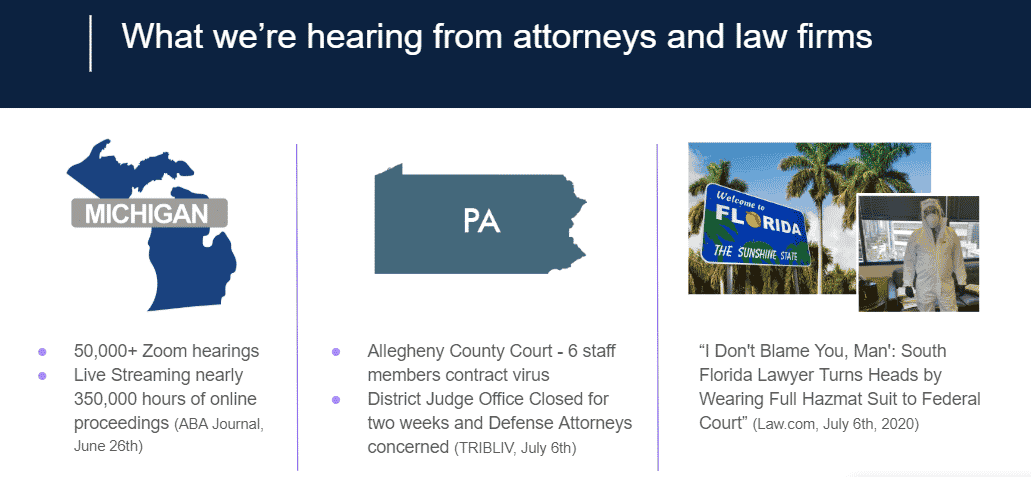An in-person industry has essentially changed overnight. In late June, judges in three US states testified in favor of the continued use of remote proceedings post-COVID-19. A former California state and federal trial judge told Congress that COVID-19 has opened the judiciary up to new technology. He noted that he doesn’t expect the legal industry to ever return back to where it was before, according to the ABA, which has even created a Coronavirus Task Force.
The CIDRAP has estimated that we must be prepared for at least another 18 to 24 months of significant COVID-19 activity, with hot spots popping up periodically in diverse geographic areas. As such, courts and the legal system continue to be adapted quickly. The legal system cannot afford to fully close and prevent justice from being served. Instead, limited or suspended proceedings and adapted rules, which take into account social distancing, have taken form.
With individuals fearful of putting themselves in unnecessary situations to catch the virus, fewer in-person depositions and proceedings are occurring and legal professionals and the courts are turning to digital means to continue to serve justice.
Social distancing fuels the need for digital
“The legal community will not be immune to the [COVID-19] changes. So, it likewise will be a world where attorneys of all ages, who previously may never have even heard of Zoom or Skype, now will question why they must get on airplanes,” said Jim Cudahy of the Speech to Text Institute.
Now, more legal agencies and their clients are becoming accustomed to remote depositions and utilizing legal transcription and deposition software tools to perform them.
Shifting to digital has also proved necessary to help these businesses stay afloat, with court reporters learning how to implement more digital tools and technologies into their daily workflows. The interesting point to note is that digital deposition tools are not new to the COVID-19 period; they’ve existed for years, but have simply seen slower adoption rates.
Legal agencies and court reporters currently have little choice, but to turn to these alternative means due to social distancing requirements. However, they’re seeing firsthand how these once-feared technologies can genuinely help them conduct depositions remotely and produce admissible transcripts. These tools, which remove travel time and manual processes, are able to seamlessly fit into their current workflows and help them take on more work and scale their businesses.
Expected impact on the legal industry
Now that more courts, attorneys, legal agencies and court reporters have experience using these tools and therefore lesser fear of them, it’s highly likely that they’ll continue to use them once the crisis has subsided. It’s also clear that the number of stenographers available to service proceedings will only continue to decrease, with more professionals retiring and fewer individuals entering the field, a problem which emerged well before COVID-19.
Digital court reporting and remote depositions are likely here to stay. Companies, such as BlueLedge are emerging and investing in this bet by helping to provide training on digital legal tools to today’s professionals.
With social distancing expected for the indefinite future, legal professionals would be wise to open their businesses up to more remote court reporting work to ensure they retain clients and remain competitive. Digital tools are not only helping to account for safety measures, but are helping with cost savings. When used correctly, the right tools, such as high-quality video can help to ensure that in-person perks, such as the ability to read a witness’s body language can still be accounted for, while also helping legal agencies to cut costs. These benefits showcase a worthwhile lasting opportunity for businesses to succeed with digital post COVID-19.
Successes and challenges to digital court reporting adoption
With the need to social distance and more individuals and court reporters turning to technologies, more findings have resulted. Identified successes and challenges during this period include:
- Success: Broader adoption, with large agencies and court systems particularly
- Success: The use of new and higher quality tools, including software, microphones and recorders, which have allowed for seamless work flows and the ability of professionals to work on files anytime from anywhere
- Success: An increased number of training programs for digital reporters
- Challenge: Varying standards of quality and best practices still exist
- Challenge: There is still some fear of the unknown and fear of new technology which exists among professionals
- Progress: Court reporters are adopting digital tools, and these numbers are only accelerating
Important digital court reporting considerations
It’s clear that more advocacy needs to occur in order to ensure legal professionals are aware of all of the tools and providers they now have access to. The right partners can help these professionals meet clients’ current needs, as well as the legal work demands which are likely to result post COVID-19.
Training reporters to provide them with a firm knowledge base on digital and transcription tools is also key. With more education, these court reporters and stakeholders will see that court reporting and remote deposition technologies are nothing to fear and easy to implement. Education on the importance of securing high-quality digital and audio recording equipment, such as professional microphones, is also critical.
The technologies available are customized to the individual needs and workflows of court reporters. The use of transcription tools, such as text expansion and automatic speech recognition technologies can only help to ensure more work is completed. For example, Verbit’s tools are designed for legal professionals to secure real-time rough drafts and admissible transcripts with guaranteed accuracy. With the right tools and partners, all stakeholders involved in these proceedings can greatly benefit both now, with the need to social distance, as well as once the crisis subsides.






